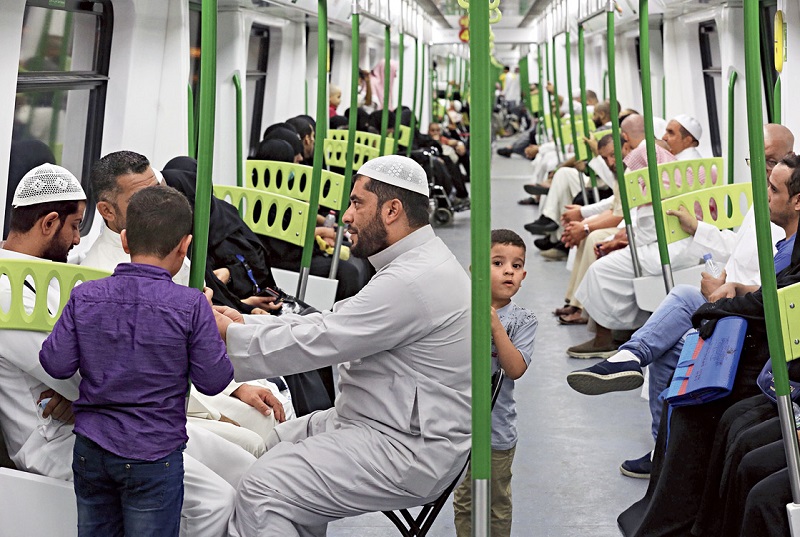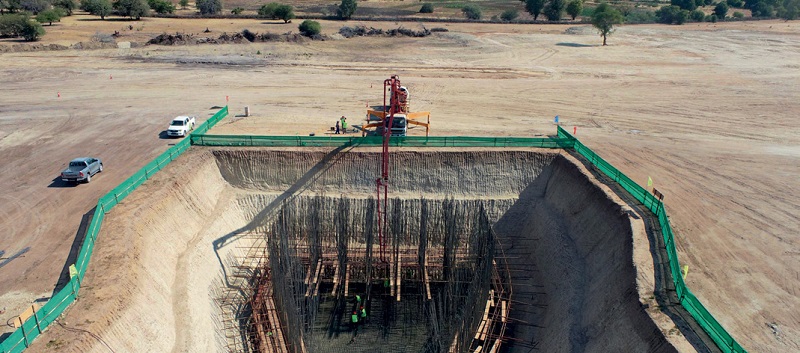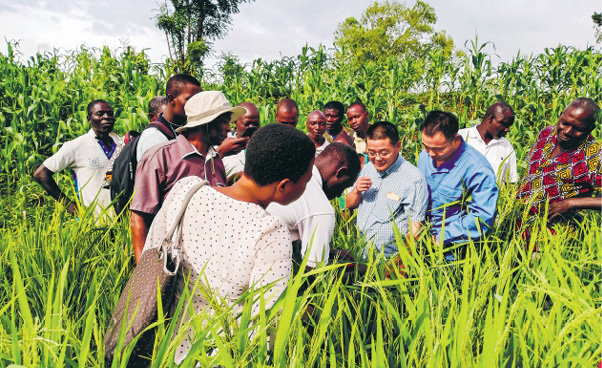The hard connectivity in infrastructure, soft connectivity in rules and standards, and heartfelt connectivity among the people of the partner countries are essential to jointly build the Belt and Road Intiative (BRI). Today, a batch of seemingly small but vital projects with sound economic and social impact are becoming priorities of cooperation, benefiting partner countries and their people. Such projects have demonstrated that jointly building the initiative is not empty talk, but translates into practical benefits like water, electricity, roads, bridges, schools and hospitals, increased income, improved living standards, and a promising future. These projects have brought people in the BRI countries closer and delivered a tangible sense of gain.

Muslim pilgrims ride on the holy sites subway from the Arafat area to Mina during the annual Hajj season in the western Saudi city of Mecca on August 22, 2018. It was built by a Chinese company and put into operation in 2010.
Access to Water Improves Lives
Pedro Cabri, a villager from Cunene Province in Angola, gets up early and herds his 15 cattle and 40 sheep to a drinking water point 200 meters away from his home.
Located in southern Angola, Cunene has an arid climate and low annual rainfall, which were previously the cause of drought. Local villagers had to get water from a natural well 10 kilometers away. The water source was mainly rain, so its quality was poor, often full of parasites. In April 2022, the first stage of a drought relief project built by the Power Construction Corporation of China (PowerChina) in Cunene Province was completed, meeting the needs of locals and becoming a channel of goodwill for the drought-plagued province.
The drought relief project includes nine reservoirs of 50,000 cubic meters each, 30 drinking water points for livestock, and a 48.71-kilometer-long canal, meeting the water demands of 250,000 people and 400,000 cows and sheep in the region. “With water, our lives have become better. It’s more convenient to get water for cattle and sheep. I plan to raise 20 more cattle next year,” said Cabri.
As the water pumps start up, clean water continuously flows from the canal to farmlands. While providing clean drinking water to local villagers, the project also provides water for irrigation of about 5,000 acres of farmlands, lending vitality to local agricultural development.
Villager Daniel’s home is near the project’s No. 3 reservoir. This place used to experience severe drought and bad harvests. After the completion of the drought relief project, Daniel became one of the first villagers to benefit. “My family has grown corn, sorghum, tomatoes, and onions, which meet our needs and provide extra foods and vegetables for sale in the market. Our lives are improving, and I have even gained much weight,” said Daniel, very relieved that he no longer needs to worry about water shortages for irrigation.
“Since the completion of the drought relief project, people’s lives have become happier,” said the country’s then Vice President Bornito de Sousa Baltazar Diogo when he inspected the project. The project supports and guarantees efforts to fight drought in southern Angola, promotes the development of husbandry in the arid area in the south, and dramatically improves people’s living standards.
During his visit to the project, Abdulla Shahid, president of the 76th United Nations General Assembly, indicated that it had laid a solid foundation for cooperation on husbandry projects between the UN and the Angola government, and hoped such a cooperation model could be promoted in other countries and regions that lack water.

Concrete is poured at the water pumping station of the drought relief project undertaken by Power Construction Corporation of China in Cunene Province of Angola on July 18, 2021.
Leisure Park in Arid Land
If you stroll along the walking path in Baish Park in the Jazan Economic City of Saudi Arabia, the vast Red Sea will be on one side and lush date palms and green lands on the other side. No one can imagine this area was a desert just a few years ago.
Jazan Economic City is one of the key economic cities listed in Saudi Arabia’s Vision 2030 plan. With a total length of 1.7 kilometers and a width of 130 meters, Baish Park is in the northwest of the city and spreads along the coast of the Red Sea. It has beaches, walking paths, sports fields, and amusement facilities. Now, the park has become a destination of leisure and entertainment for nearby residents and the largest and best-equipped leisure park in southwestern Saudi Arabia.
Baish Park was constructed by China Harbor Engineering Co. Ltd (CHEC). “The Chinese team has overcome multiple difficulties and honored its commitment to build a high-quality project, receiving high recognition from the proprietor and local government,” said Yang Zhiyuan, general manager of CHEC Middle East Regional Management Center and head of Jazan projects. As a comprehensive coastal urban development project, Baish Park involves a range of areas like landscape engineering, building structure, and power system. “Take the irrigation system as an example. Considering the severe water shortage in the region, the construction team followed the principle of fully using the water resources and adopted a two-step irrigation technology to design an automatic irrigation system for the park, saving a large amount of water. After the completion of the project, the coconut trees, clean water, and white sand in the park have attracted more and more people for leisure,” said Yang.
Abdulla, who enjoys strolling by the sea, has grown up in the area. He told reporters that the coast of the Red Sea has a unique scenery, but leisure facilities surrounding Jazan Economic City have been limited. Baish Park has extended people’s leisure space. “The park has a variety of fitness facilities and a small amusement park tailored for children, who have fun every time they come here,” said Abdulla.
As part of Jazan Economic City, Baish Park is a vivid example of a better future under China-Saudi Arabia cooperation. Saudi employee Tahir Hamad joined CHEC in 2013. Over the past decade, he has participated in projects like commercial ports in Jazan and witnessed the expansion of Jazan Economic City and the improvement of its facilities. “During construction, builders from Saudi Arabia and China worked together and completed one project after another. Today, China-Saudi Arabia industrial clusters are making steady progress, contributing to improving the local economy and livelihoods. As a Jazan native, I’m happy to see the achievements made by our bilateral cooperation,” said Hamad.

Experts from Win-All Hi-Tech Seed, a subsidiary of Sinochem Holdings Corporation Ltd., explain key technologies and field management skills during the rice earing (flowering) period to local farmers at a demonstration field in Togo.
Chinese Businesses Solving Urgent Challenges
The production line is running at full capacity in a medical glove making factory on the western outskirts of Tashkent, capital of Uzbekistan. The gloves are made through automatic processing before heading to the market.
Though these gloves may seem ordinary, they are an example of the friendship between the peoples of China and Uzbekistan. In March 2020, when COVID-19 was raging, Uzbekistan was in desperate need of materials to fight the pandemic. Dentafill, the country’s leading medicine and medical materials manufacturer, was eager to find a partner to produce medical gloves. After hearing of Dentafill’s need, China Meheco Group Co., Ltd. of China General Technology (Group) Holding Co., Ltd. reached out and helped the company contact a Malaysian business to import a production line of medical gloves.
Then, despite strained transport capacity, Genertec Meheco delivered 27 containers of equipment in four batches via shipping and China-Central Asia freight rail, helping Dentafill assemble a production line for medical gloves with a designed output of over 300,000 pairs per day. Sherzod, head of the production workshop, spoke highly of the Chinese business efficiency, “With Chinese help, the factory completed assembling work in just half a year. The production line’s scale and technology are at the top level in Uzbekistan.”
Businesses from China and Uzbekistan have cooperated across production chains, from raw material processing to production technology and from quality control to delivery, to ensure the best results in each process. Sherzod applied for a post in the glove factory on its completion. “The working environment is excellent, and the production line is advanced. I can learn many skills. More importantly, the factory is close to my home, and I can better care for my family. I want to thank the Chinese business for its support and help,” said Sherzod.
The large number of medical gloves that came off the production line effectively addressed the massive local shortage of the items during the pandemic. Now, businesses from China and Uzbekistan are discussing strengthening the localized production of health products to promote industrial development in Uzbekistan and neighboring Central Asian countries. “Chinese businesses helped us solve our pressing problems. We found a sincere partner in times of difficulty and received unconditional support and help. We’re so grateful,” said Dentafill CEO Sarkor Isonbaev. 
The article was first published in People’s Daily.
